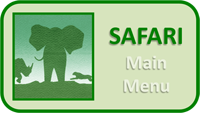
As the 1970's dawned, the concept of zoos began to fade in popularity
around the country as people began to feel that the confines of cages
were cruel and inhumane. In response, safari parks began to crop up,
allowing the animals to roam freely while the people were confined to
vehicles. Great Adventure looked to be the biggest and the best in
everything they did, and the Safari was built and billed as the "Largest
Drive-Through Safari Outside of Africa" with hundreds of free roaming
animals in a naturalistic environment.
|
|
|
|
All contents of this Spotlight are from the Safari Park's first
season in 1974. |
|
|
 |
| |
|
|
Covering several hundred acres of
lush forest and lakes, the Safari was designed so that guests could
transverse the park via a three lane roadway. Cars entered the Safari through
the rustic looking toll plaza. Here guests paid to enter and were given
the rules and a guide pamphlet.
One common problem encountered
in the Safari, especially on hot summer days, was car radiators
overheating in the stop and go traffic as people crawled through to
watch the animals. The Safari wardens spent almost as much time helping
stranded motorists as they did tending their animals. |
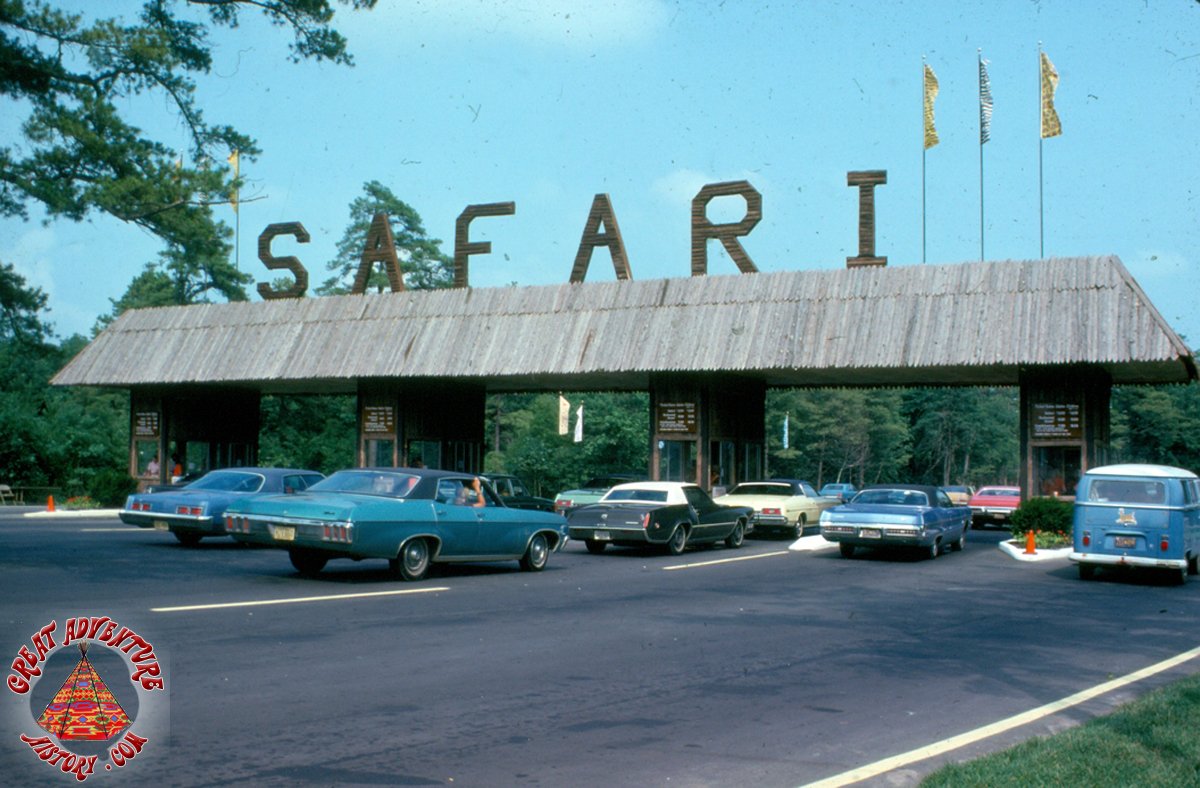 |
| |
|
|
ORIGINAL
SAFARI SECTIONS
I. Roosevelt Elk, White Elk, White Tailed Deer, N.A. Buffalo, Rhea,
European Red Deer, Llama
II. African Elephant, White Rhino, Ostrich
III. Giraffe, Sable Antelope, Impala, White Tailed Gnu, White Bearded
Gnu, Nyala, Gazelle, Kudu, Oryx, Gemsbok, Addax, Scimitar Oryx, Beisa
Oryx, Hartebeest, Waterbuck, Eland, Zebra, Dromedary Camel
|
CLICK THE IMAGE BELOW
TO WATCH A VIDEO OF
THE SAFARI PARK IN 1974

|
IV. Lions
V. American Black Bear
VI. Bengal Tigers
VII. European Brown Bear
VIII. Pelicans, Flamingos, Black Swan, Mute Swan, White Swan, Geese,
Ducks, Mallards
IX. Cheetah
X. Leopards
XI. Siberian Tigers
XII. Mouflon Sheep, Siberian Ibex, Aoudad
XIII. Baboon, Monkey |
| |
|
| |
|
|
Although initial plans were for
all of the park's animals to cohabitate the 450 acres without any fences
separating the species similar to how they live in nature, it was soon
learned that dividing fences were going to be a requirement if all the
species were going to survive. The park was soon divided into 13
sections.
The first area of animals
encountered featured animals of the
American plains like elk and buffalo along with South American animals
like llamas and rheas. The area was left heavily wooded initially, but
the trees would fall victim to the animals, storms, as well as vehicles over
time. |
 |
| |
|
|
 |
 |
 |
| |
|
|
 |
One of the biggest
challenges of the Safari's grasslands was keeping them covered with
grass as the herds of grazing animals often cleared the soil of all
vegetation. The sandy soil was poor for growing grass to start with, and
the herds tended to clear it all despite being given hay and feed
throughout the day.
Larger feeders were strategically positioned throughout the Safari to
provide the animals with shaded serving areas while offering great views
of the feeding animals to guests passing by in their cars. |
 |
| |
 |
| |
|
|
 |
 |
| |
 |
| |
|
|
 |
To enhance the
natural beauty of the Safari, the designers made use of existing streams
and ponds while also creating several additional watering holes for the
comfort of the animals. Over a dozen of these refreshing pools
dotted the Safari's landscape.
On the hottest days
the water holes were often packed with the herds of deer, elk and bison
as they looked to escape the heat. Often the waterlogged animals
would exit the ponds and make their way onto the roadway where they
would shake off the excess water and give the autos an unexpected car
wash. |
 |
| |
|
 |
 |
| |
|
|
 |
 |
 |
| |
|
|
 |
 |
 |
| |
|
|
 |
 |
 |
| |
|
|
One of the most popular animal
areas was the elephants. The twenty nine African elephants primarily had
been brought as a herd from Uganda. Like the plains, the elephant area
originally featured many trees, but those quickly fell victim to the
giant animals which would snap many of the tree trunks like toothpicks.
Even though the elephants shared this area of the Safari with the rhinos
and the ostriches, all these animals usually managed to keep to
themselves in their respective herds. |
 |
| |
|
|
 |
The herd of elephants
quickly adapted to their new home, enjoying the lake and the hills of
their section. The elephants initially had free range of their
territory. The wardens were responsible for keeping them out of
the roadway and away from the cars. A huge feeding station and
pond was positioned in the middle of the area's central savannah to
encourage the elephants to stay away from guests.
For the safety of the guests, wardens, and the elephants
themselves, they would eventually be corralled into a huge pen in the
center of the Elephant and Rhino section. |
 |
| |
|
 |
 |
| |
|
 |
 |
| |
|
|
 |
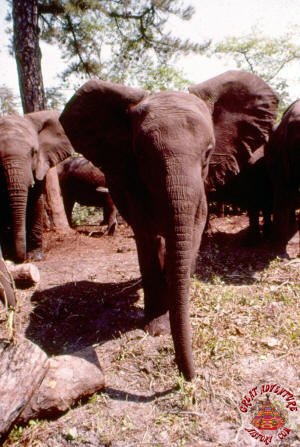 |
 |
| |
|
|
 |
 |
 |
| |
|
|
 |
 |
 |
| |
|
|
 |
 |
 |
| |
|
|
 |
The white rhinos
shared the African area of the Safari with the elephants, and together
they pretty much killed the grass and trees between their grazing and
just walking on the grass.
The rhinos were found in and closer to the roadway more often than the
elephants. It was frequently possible to see a rhino playing
chicken with one of the many white and black striped Safari trucks when
they felt challenged or simply playful. |
 |
| |
|
 |
 |
| |
|
|
 |
 |
| |
 |
| |
|
|
 |
 |
 |
| |
|
|
 |
 |
 |
| |
|
|
 |
 |
 |
| |
|
|
 |
 |
 |
| |
|
|
Ostriches also shared the African
section with the elephants and rhinos. While the other, bigger animals
tended to steer clear of the passing cars, the ostriches showed no fear
and would often walk right up to the vehicles.
The giant birds often would walk
up to car windows and look for handouts from the passing cars which
would tie up traffic as they blocked one or more of the three lanes. |
 |
| |
|
|
 |
Hubcaps were a standard feature
of most model cars in the 1970's. These reflective metal discs
were like rolling mirrors for the ostriches and it was common to watch
an ostrich admiring itself in a neighboring car's tire.
Amazed at what it was seeing the ostrich would sometimes attack and peck
at the hubcap thinking it was another ostrich. Other times, the
ostrich would just stare and actually tilt its neck as the tires would
start to roll as the cars began to creep away. |
 |
| |
|
|
 |
 |
 |
| |
|
 |
 |
| |
|
|
 |
 |
 |
| |
|
|
 |
The African plains section held the
giraffes, zebras, wildebeests and other animals of the grasslands. Like
the other areas, great care was taken to preserve the trees and grow
grass, but the large herds stripped the trees of leaves and ripped up
large areas of the newly planted grass.
The grazing animals in this area munched on so much of the grass that it
often required the herds to be restricted to certain regions so that the
grass growth could recover.
|
| |
|
|
 |
 |
 |
| |
|
|
 |
In the years ahead, this section of the Safari would remain completely
closed with the animals relocated to other areas so that the ground
cover could truly reestablish itself.
The giraffes were also particularly destructive to the
trees. Growing to height of nearly 20 feet, few leafs were safe
from a giraffe's lofty reach. In later years the trees would have fences,
wire mesh, and other
protections to keep the giant animals from nibbling on their bark and killing them. |
 |
| |
 |
| |
|
|
 |
 |
 |
| |
|
|
 |
 |
 |
| |
|
 |
 |
| |
|
|
 |
Along with all the
African herd animals, the African plains also had dromedary camels. In
later years the camels would be moved to other areas as the size of the
other herds grew larger and larger.
One of the missions of the Safari was to provide a place for "animals to
survive and thrive" while providing an "environment of a safari park,
where they can roam and have the proper food in abundance".
The park surely met its goals as so many newborns were born and the
Safari's population quickly skyrocketed. |
 |
| |
|
 |
 |
| |
|
|
 |
 |
 |
| |
|
|
 |
 |
 |
| |
|
|
 |
 |
 |
| |
|
|
The variety and numbers of
animals in the African Plains was breathtaking and really gave the
guests passing through the Safari a true sense of what the great herds
of the African plains looked like.
While the Safari was a feast for the eyes, it also provided an
educational experience through sound provided by a specially recorded
narration delivered to the guests on a designated AM radio station.
The signal was broadcasted via a wire embedded in the roadway under the
center lane of traffic. |
 |
| |
|
|
 |
 |
 |
| |
 |
| |
|
|
 |
At the halfway point of the
Safari the animals went from the grazers to the carnivores with the big
cats and bears. To enter this area cars passed through a set of gates
that would allow them in as a group, keeping the dangerous animals
inside. The double gates were overseen by a warden in a tower who could
watch both ends of the gated area, keeping the grazers out of the
carnivore area and the carnivores away from the grazers. |
| |
|
|
 |
 |
 |
| |
|
|
 |
The lions were the
first of the carnivorous animals encountered, roaming freely throughout
their area. The large pride could be found on both sides of and
occasionally on the road as motorists passed by with nothing but their
car windows keeping them safe from the big cats.
Observant patrons might have also noticed that wardens in the carnivore
sections had rifles mounted on the back window of their Safari jeeps.
These were meant to serve purely as a last resort measure in a life
threatening situation. |
 |
| |
|
 |
 |
| |
|
|
 |
 |
 |
| |
|
|
 |
 |
 |
| |
|
|
 |
 |
 |
| |
|
|
 |
 |
 |
| |
|
 |
 |
| |
|
|
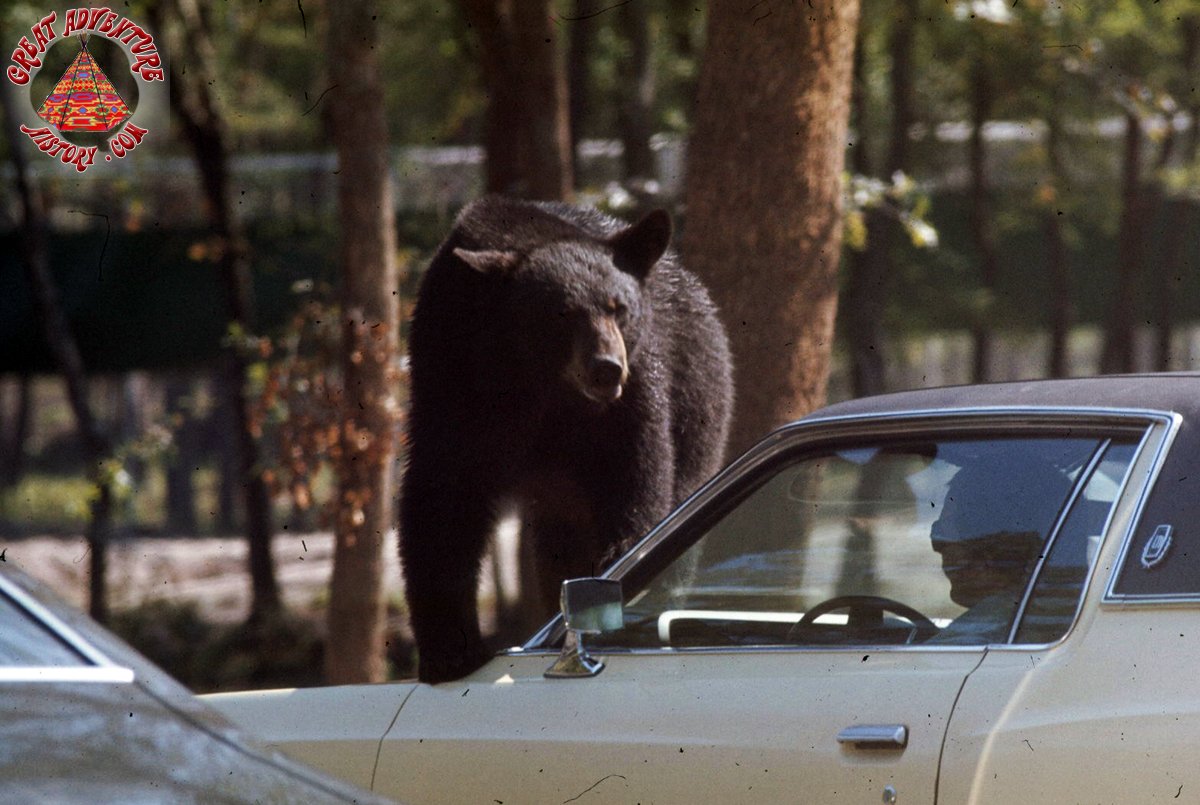 |
The black bears were the next
area of the Safari, with the giant omnivorous animals wandering freely
and even sitting on cars. Their keen noses could find any car with food
in it and they would often need to be moved away by wardens to allow the
vehicles to move on.
In the Safari's earliest days when the park had bumper to bumper
traffic, it was requested that cars stay either in the left or right
lanes and only use the center lane to switch sides. The center
lane was to be left open so that the Safari vehicles could patrol the
park. |
| |
|
|
 |
 |
 |
| |
|
|
 |
 |
 |
| |
|
 |
 |
| |
|
|
The Bengal tigers, like the
lions, had free reign of their area. The giant cats could wander right
up to the passing cars, though most of the time they spent their days
laying in the shade or the watering hole.
When the Safari opened in 1974 it had several large cat areas.
Overtime some of these regions were converted into other realms
including a new Australian section which opened in 1979. |
 |
| |
|
|
 |
 |
 |
| |
|
|
 |
The European brown
bears were the next group of animals encountered and their large section
was also heavily wooded when the Safari first opened. The woods also
fell victim to the animals as they scratched, climbed and ate the leaves
off the trees.
The brown bears also had free reign of their area
initially, but for safety they would eventually be contained behind
electric barriers. Often the bears would climb under passing cars
and try to nap beneath the vehicles. This obviously caused great
delays as well as a dangerous situation for the wardens that had to
nudge out the sleeping bears. |
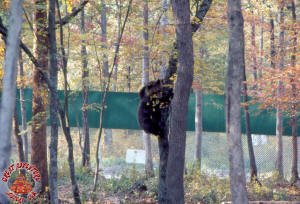 |
| |
|
 |
 |
|
|
|
 |
 |
 |
| |
 |
 |
|
At the lowest point of the Safari, a natural pond
formed. The native woodlands were left undisturbed and this area
became the bird sanctuary, with exotic species like flamingos side by
side with native species like mallards and Canadian geese. |
| |
 |
| |
|
|
 |
 |
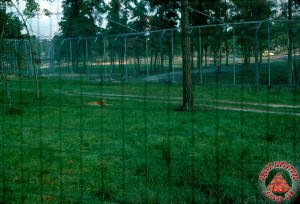 |
| |
|
The most dangerous
animals in the Safari were the cheetahs, leopards, and Siberian tigers,
all of which kept behind fences for safety. The leopards, which
included yellow spotted, brown spotted, and black spotted with black
coats (panthers) made up the only group of cats of its kind in captivity
at the time.
After
leaving the predators area gates, guests came to a region of more
grassland animals like mountain goats, aoudad, and ibex. This area
contained the largest manmade change in elevation at the park so that
some of the species could climb on the abundant rocks. |
 |
| |
|
 |
 |
| |
|
|
 |
 |
 |
| |
|
|
 |
The final, and most memorable
section of the Safari for most guests was the monkeys and baboons. The
curious animals had no fear at all with the vehicles and often climbed
all over the passing cars. They would sometimes become destructive,
tearing off wipers, antennas, lights and anything else they could pull
off. For this reason, canvas tops were not allowed and a bypass road was
created in 1975. The clever monkeys would also jump into the beds of pickup
trucks as they attempted to escape through the exit gate. The wardens
often had their hands full shooing the animals back into the Safari. |
| |
|
|
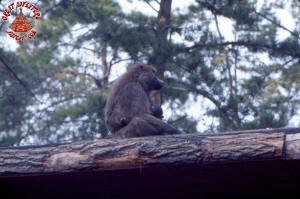 |
 |
 |
| |
|
|
 |
 |
 |
| |
|
|
 |
 |
 |
| |
|
 |
 |
| |
|
|
| Original Press Related Materials
from 1974 |
| |
|
|
 |
 |
 |
| |
|
|
 |
 |
 |
| |
|
|
 |
The scale and scope of the Safari
was something really unique about Great Adventure, and originally the
Safari was as much a draw for Great Adventure as the Enchanted Forest
theme park. The huge variety of species and the sheer number of animals
that could be seen along the journey was and always has been a unique
experience found nowhere else in the world. |
 |
| |
|
|
 |
 |
 |
| |
|
|
 |
 |
 |
| |
|
|
 |
 |
 |
| |
|
|
 |
 |
 |
| |
|
|
 |
 |
 |
| |
|
|


